Tag: graphic-statics
-
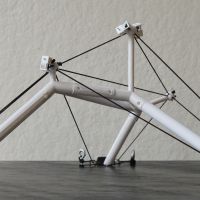 Funicular post-tensioning of 3D structuresResearch, 2017 - Present
Funicular post-tensioning of 3D structuresResearch, 2017 - PresentPost-tensioning of curved structures in two dimensions allows designers to convert a non-funicular shape into a funicular one by introducing additional loads to the structure, generally improving the structure efficiency. However, for complex geometries or loading conditions, two-dimensional analysis is not always sufficient to assess structures' behavior. The objective of this research is to expand the methods developed for the design of externally post-tensioned curved structures to the third dimension. The novel methods of three-dimensional graphic statics are explored to create a new methodology adapted to spatial structures.
-
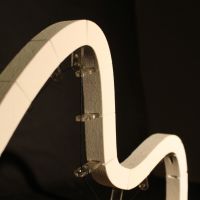 Externally post-tensioned structures: validation through physical modelsLeonardo Todisco and Caitlin Mueller, Proceedings of the 3rd International Conference on Structures and Architecture, 2016
Externally post-tensioned structures: validation through physical modelsLeonardo Todisco and Caitlin Mueller, Proceedings of the 3rd International Conference on Structures and Architecture, 2016Funicular structures, which follow the idealized shapes of hanging chains under a given loading, are recognized as materially efficient structural solutions because they exhibit no bending under normal loading conditions and minimize the amount of required members, often reducing the amount of material needed. However, non-structural conditions, such as aesthetics, functionality, and geotechnical issues, often prohibit selection of a structurally ideal funicular shape: bending moments inevitably arise, decreasing the structural efficiency of the design.
This paper briefly describes how a new design philosophy consisting in the introduction of additional loads, using external post-tensioning cables, can convert a non-funicular structure into a funicular one without changing its starting geometry. This system is based on the possibility of introducing external forces into the main structure through a system of stressed tension cables and compressive or tension struts resulting in changing internal force distribution.
The theoretical approach, based on graphic statics, has been generalized for any two-dimensional geometry. The method has been implemented in a parameterized and interactive environment allowing the fast exploration of different equilibrated solutions.
This paper focuses on the physical modeling, testing, and validation of structures implementing this approach. The structures are modelled through reduced-scale non-funicular geometries fabricated through additive manufacturing (3D printing), with the post-tensioning system constructed with thin cable and precise laser-cut struts. Slow motion video captures show how three different non funicular geometries (pointed-arch, circular arch and free form curve), made of discrete elements and without bending strength, stand only if the cable is working in the appropriate way, demonstrating the efficacy of the new system.
Furthermore, this paper introduces a built example on the scale of real building systems. The paper describes the design and construction process of a post-tensioned pavilion structure. This pavilion, called Funicular Explorations, serves as both a validation and demonstration of this new method, expressing the creative freedom of designers and the structural performance of the results. The design is an array of eight two-dimensional curves, made from custom-cut corrugated cardboard and nylon webbing. The array begins with a funicular parabolic arch, and progresses toward a visually expressive but structurally arbitrary shape. The external post-tensioning system contributes increasingly from one curve to the next, finally allowing the terminal free-form shape to be achieved with axial forces only.
The use of physical models, independent of their scale, is informative but also didactic, illustrating the possibilities and trade-offs in funicular explorations for architectural design. Furthermore such models demonstrate the structural concept behind the post-tensioning system in an intuitive way. The aim of this research is to allow architects and structural engineers a way to achieve high-performance, efficient, and safe designs, even when the global geometry departs from classical funicular shapes.
-
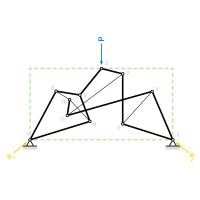 Modelling with forces: grammar-based graphic statics for diverse architectural structuresJuney Lee, Corentin Fivet, and Caitlin Mueller, Modelling Behaviour: Proceedings of the Design Modelling Symposium, Copenhagen 2015, 2015
Modelling with forces: grammar-based graphic statics for diverse architectural structuresJuney Lee, Corentin Fivet, and Caitlin Mueller, Modelling Behaviour: Proceedings of the Design Modelling Symposium, Copenhagen 2015, 2015Most architectural modelling software provides the user with geometric freedom in absence of performance, while most engineering software mandates pre-determined forms before it can perform any numerical analysis. This trial-and-error process is not only time intensive, but it also hinders free exploration beyond standard designs. This paper proposes a new structural design methodology that integrates the generative (architectural) and the analytical (engineering) procedures into a simultaneous design process, by combining shape grammars and graphic statics. Design tests presented will demonstrate the applicability of this new methodology to various engineering design problems, and demonstrate how the user can explore diverse and unexpected structural alternatives to conventional solutions.
-
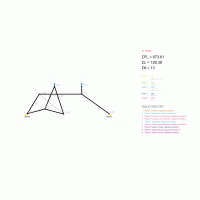 Grammar-based generation of equilibrium structures through graphic staticsJuney Lee, Corentin Fivet, and Caitlin Mueller, Proceedings of the International Association for Shell and Spatial Structures (IASS) Symposium 2015, 2015
Grammar-based generation of equilibrium structures through graphic staticsJuney Lee, Corentin Fivet, and Caitlin Mueller, Proceedings of the International Association for Shell and Spatial Structures (IASS) Symposium 2015, 2015This paper proposes a grammar-based structural design methodology using graphic statics. By combining shape grammars with graphic statics, this method enables the designer to: 1) rapidly generate unique, yet functional structures that fall outside of the expected solution space, 2) explore various design spaces unbiasedly, and 3) customize the combination of grammar rules or design objectives for unique formulation of the problem. Design tests presented in this paper will show the powerful new potential of combining computational graphic statics with shape grammars, and demonstrate the possibility for exploring richer and broader design spaces with much more trial, and less error.
-
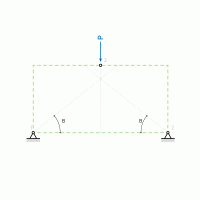 Grammatical design with graphic statics: rule-based generation of diverse equilibrium structuresJuney Lee, MIT MEng Thesis, 2015
Grammatical design with graphic statics: rule-based generation of diverse equilibrium structuresJuney Lee, MIT MEng Thesis, 2015During early stages of design, an architect tries to control space by “finding a form” among countless possible forms, while an engineer tries to control forces by “form-finding” an optimized solution of that particular form. Most commonly used parametric tools in architectural design provide the user with extensive geometric freedom in absence of performance, while engineering analysis software mandates pre-determined forms before it can perform any numerical analysis. This trial-and-error process is not only time intensive, but it also prohibits exploration beyond the design space filled with already known, conventional solutions. There is a need for new design methods that combine form generation with structural performance.
This thesis addresses this need, by proposing a grammar-based structural design methodology using graphic statics. By combining shape grammars with graphic statics, the generative (architectural) and the analytical (engineering) procedures are seamlessly integrated into a simultaneous design process. Instead of manipulating forms with multiple variables as one would in the conventional parametric design paradigm, this approach defines rules of allowable geometric generations and transformations. Computationally automated random generator is used to iteratively apply various rules to generate unexpected, interesting and yet structural feasible designs. Because graphic statics is used to embed structural logic and behavior into the rules, the resulting structures are always guaranteed to be in equilibrium, and do not need any further numerical analysis. The effectiveness of this new methodology will be demonstrated through design tests of a variety of discrete, planar structures.
Grammatical Design with Graphic Statics (GDGS) contributes new ways of controlling both form and forces during early stages of design, by enabling the designer to: 1) rapidly generate unique, yet functional structures that fall outside of the expected solution space, 2) explore various design spaces unbiasedly, and 3) customize the combination of grammar rules or design objectives for unique formulation of the problem. Design tests presented in this thesis will show the powerful new potential of combining computational graphic statics with shape grammars, and demonstrate the possibility for richer and broader design spaces with much more trial, and less error.
-
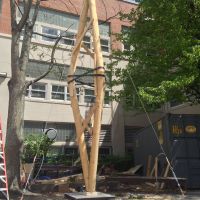 Whole-timber structural systemsResearch, 2014 - 2015
Whole-timber structural systemsResearch, 2014 - 2015Trees, when used as structural elements in their natural, round form, are up to five times stronger than the largest piece of dimensioned lumber they could yield. Additionally, these whole-timbers have a lower effective embodied carbon than any other structural material. When combined into efficient structural configurations and joined using specially-engineered connections, whole-timber has the potential to replace entire steel and concrete structural systems in large-scale buildings, bridges, and infrastructure. Whole-timber may be the most appropriate structural solution for a low-carbon and fully renewable future in both developed temperate regions and the developing Global South. To reduce barriers to adoption, including project complexity and cost, a standardized “kit of parts” in whole-timber is proposed. This project proposes new designs for the first and most important element of this kit: a structurally independent column in whole-timber. A 20’ compound column in whole-timber is prototyped at full-scale. New, simple calculation methods are developed for estimating the buckling capacity of tapered timbers. Based on conservative assumptions, the embodied carbon of whole-timber column systems is shown to be between 30% and 70% lower than conventional steel systems.
-
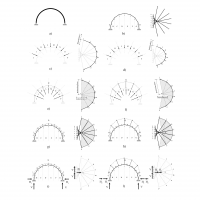 Design and exploration of externally post-tensioned structures using graphic staticsLeonardo Todisco, Corentin Fivet, Hugo Corres, and Caitlin Mueller, Proceedings of the International Association for Shell and Spatial Structures (IASS) Symposium 2015, 2015
Design and exploration of externally post-tensioned structures using graphic staticsLeonardo Todisco, Corentin Fivet, Hugo Corres, and Caitlin Mueller, Proceedings of the International Association for Shell and Spatial Structures (IASS) Symposium 2015, 2015Funicular structures, which follow the shapes of hanging chains, work in pure tension (cables) or pure compression (arches), and offer a materially efficient solution compared to structures that work through bending action. However, the set of geometries that are funicular under common loading conditions is limited. Non-structural design criteria, such as function, program, and aesthetics, often prohibit the selection of purely funicular shapes, resulting in large bending moments and excess material usage. In response to this issue, this paper explores the use of a new design approach that converts non-funicular planar curves into funicular shapes without changing the geometry; instead, funicularity is achieved through the introduction of new loads using external post-tensioning. The methodology is based on graphic statics, and is generalized for any two-dimensional shape. The problem is indeterminate, meaning that a large range of allowable solutions is possible for one initial geometry. Each solution within this range results in different internal force distributions and horizontal reactions. The method has been implemented in an interactive parametric design environment, empowering fast exploration of diverse axial-only solutions. In addition to presenting the approach and tool, this paper provides a series of case studies and numerical comparisons between new post-tensioned structures and classical bending solutions, demonstrating that significant material can be saved without compromising on geometrical requirements.
-
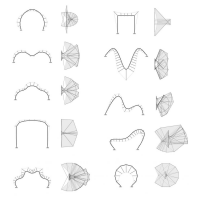 Design and exploration of externally post-tensioned structures using graphic staticsLeonardo Todisco, Corentin Fivet, Hugo Corres, and Caitlin Mueller, Journal of the IASS, 2015
Design and exploration of externally post-tensioned structures using graphic staticsLeonardo Todisco, Corentin Fivet, Hugo Corres, and Caitlin Mueller, Journal of the IASS, 2015Funicular structures, which follow the shapes of hanging chains, work in pure tension (cables) or pure compression (arches), and offer a materially efficient solution compared to structures that work through bending action. However, the set of geometries that are funicular under common loading conditions is limited. Non-structural design criteria, such as function, program, and aesthetics, often prohibit the selection of purely funicular shapes, resulting in large bending moments and excess material usage. In response to this issue, this paper explores the use of a new design approach that converts non-funicular planar curves into funicular shapes without changing the geometry; instead, funicularity is achieved through the introduction of new loads using external post-tensioning. The methodology is based on graphic statics, and is generalized for any two-dimensional shape. The problem is indeterminate, meaning that a large range of allowable solutions is possible for one initial geometry. Each solution within this range results in different internal force distributions and horizontal reactions. The method has been implemented in an interactive parametric design environment, empowering fast exploration of diverse axial-only solutions. In addition to presenting the approach and tool, this paper provides a series of case studies and numerical comparisons between new post-tensioned structures and classical bending solutions, demonstrating that significant material can be saved without compromising on geometrical requirements.
-
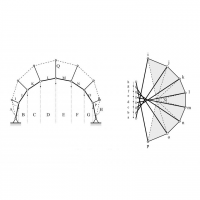 Externally post-tensioned curved structuresResearch, 2014 - 2015
Externally post-tensioned curved structuresResearch, 2014 - 2015Curved structures are characterized by the critical relationship between their geometry and structural behavior, and selecting an appropriate shape in the conceptual design of such structures is important for achieving efficiency. However, non-structural conditions, such as aesthetics, functionality, and geotechnical issues, often prohibit selection of a structurally ideal funicular shape. This research explores the possible introduction of additional loads that convert a non-funicular shape into a funicular one without changing its base geometry, through the use of external post-tensioning systems. To achieve this, a new generalized methodology based on graphic statics is developed.


